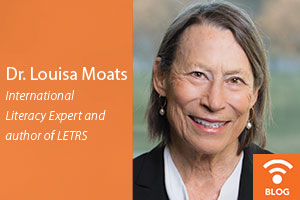Reflections on the 2019 NAEP: Where Do We Go Now?
by Dr. Louisa Moats on Nov 5, 2020
 Results of the 2019 National Assessment of Educational Progress (NAEP) are in, and the picture is not pretty when it comes to either 12th grade reading or fourth grade reading scores.
Results of the 2019 National Assessment of Educational Progress (NAEP) are in, and the picture is not pretty when it comes to either 12th grade reading or fourth grade reading scores.
Mississippi was the only state to show significant improvement between 2017 and 2019 in fourth grade reading. Many other states lost ground. The national gap between White and Black has widened across all grades, with children of color, English learners, and poor children occupying the “below basic” realm in even greater numbers. From the high school level to the early elementary years, we are failing our kids.
What are we to conclude from this portrait of our nation’s schools when it comes to teaching kids how to read and comprehend? Remember, these data were collected before COVID interrupted schooling. We have no way of knowing which of many factors can be blamed for the stagnation and regression in fourth grade reading across the country, but the fact that Mississippi continues to improve while others do not, supports a few conjectures.
Mississippi is not a rich state, either in terms of its government or its median income for families. It has a larger African-American population than many northern states that have been losing ground. For years, it was last in the nation in reading achievement. Nevertheless, state leadership, who were “tired of being last,” according to the superintendent, coalesced around a commitment to improve.
With the support and facilitation of the Barksdale Reading Institute, the state embraced the body of information known as “the science of reading” throughout higher education, elementary education, preschool education, and support services.
Professional development with LETRS®, coupled with classroom coaching, has been a mainstay of teacher education and support in Mississippi. Higher education course instructors have also participated in LETRS and helped to upgrade their offerings so that teacher candidates can pass a rigorous licensing test aligned with reading science. Barksdale continues to offer professional development resources and to guide schools toward better curriculum choices.
Why aren’t all states doing something similar, with equivalent results? What are the barriers to continuous improvement when it comes to this most essential of academic skills—grade-level reading?
First is the matter of entrenched but mistaken ideas about learning to read, promoted through some very popular and widely used classroom and intervention programs, that lead to counterproductive (and scientifically refuted) teaching. Chief among these ideas is that children can learn to decode, recognize words, and spell them through contextual guessing strategies (the three-cueing systems approach). Explicit and systematic teaching of phoneme awareness, phonics, spelling, and fluent word recognition is largely absent from those approaches, in spite of the fact that some pay lip service to the “ph” words. Districts have invested a lot of money in these programs and will be slow to replace them for that reason.
Second is that learning to read and write are complex cognitive and linguistic skills that, in general, are not easy to understand. Unless teachers have been through a few meaty courses to learn how reading works, how language works, how print works, and why some kids have trouble, they are being asked to do a job for which they are not adequately prepared.
Third, the standards movement during the last 10 years has gobbled up resources in curriculum development, teacher education, and assessment that have missed the mark when it comes to ensuring all kids have a foundation in reading and writing. While high standards may have accelerated the learning of a few kids at the top, kids who are not so gifted are not getting what they need. As one of my family members, a fourth grade teacher, said, “Why am I having to teach these kids how to embed quotes in an essay when they are reading at a second grade level?” What has been lost is the flexibility to align instruction with what kids need, with the practice necessary for them to consolidate and apply those skills with success and confidence.
And last, perhaps the most intangible but important challenge: How do we get kids to read books? Screen time is out of hand, and that’s one huge obstacle to confront. But kids might treasure books and read more if a) they could read the words and parse the language, and b) they routinely experienced the joy of a shared reading experience.
How does that happen? The teacher picks a text that is rife with meaning and milks it for all it’s worth, digging into it from every angle, bringing the kids along in the investigation of what it means. No matter how it’s accessed—by listening or reading—the rich story or article seduces the mind and heart and takes us to other worlds. That is the way we become readers.
Louisa C. Moats, Ed.D., is an internationally recognized authority on literacy education and is widely acclaimed as a researcher, speaker, consultant, and trainer. Dr. Moats received her doctorate in reading and human development from the Harvard Graduate School of Education and is widely published on reading instruction, the professional development of teachers, and the relationship between language, reading, and spelling.
To read the 2019 NAEP Report: nationsreportcard.gov/mathematics/supportive_files/2019_infographic_G12_math_reading.pdf







